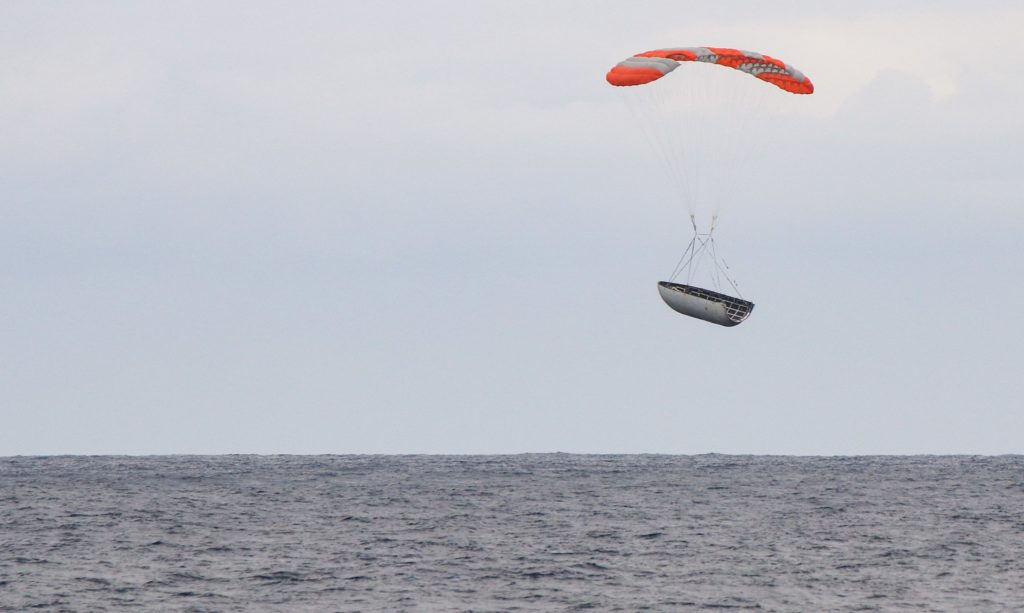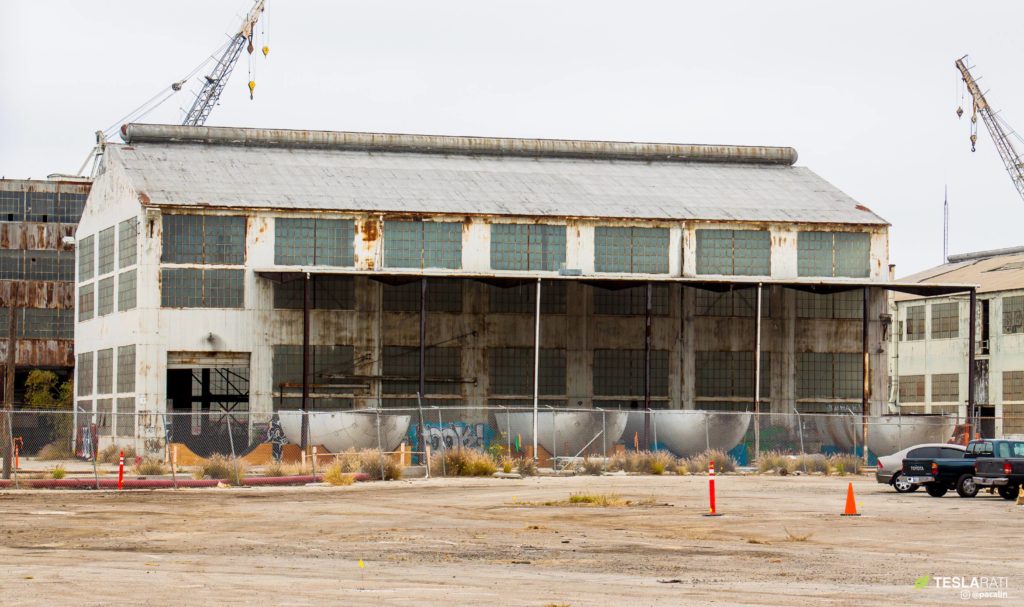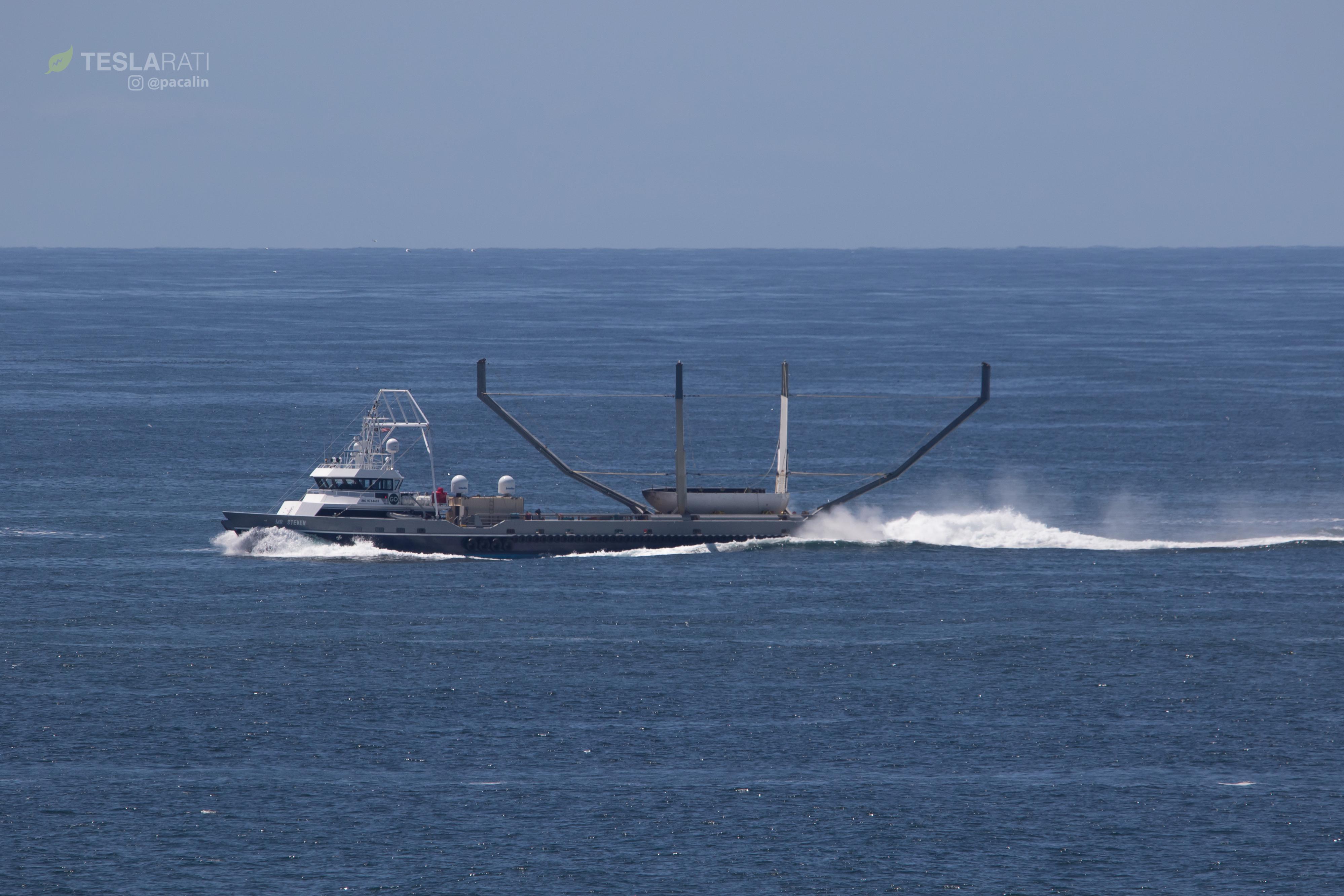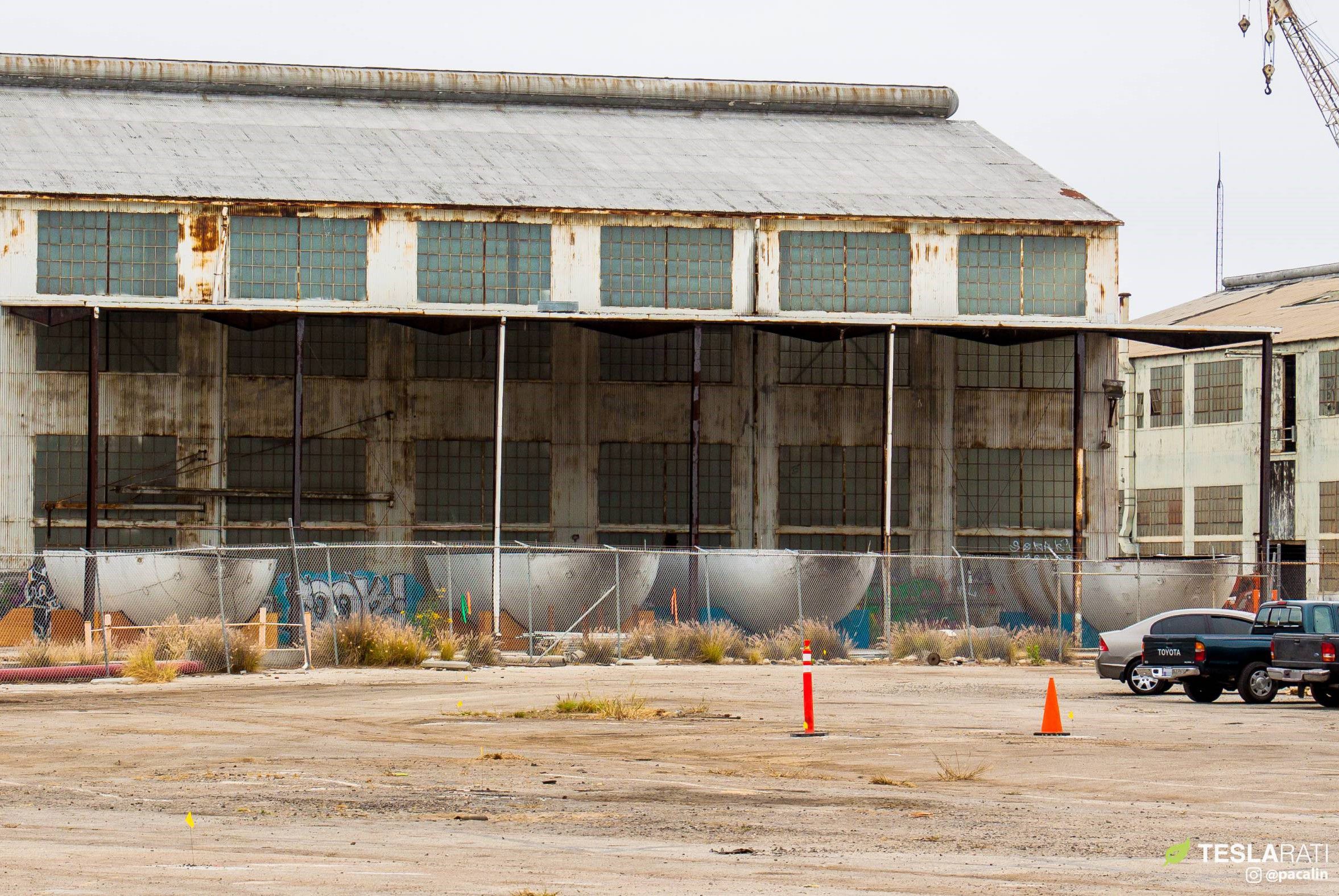
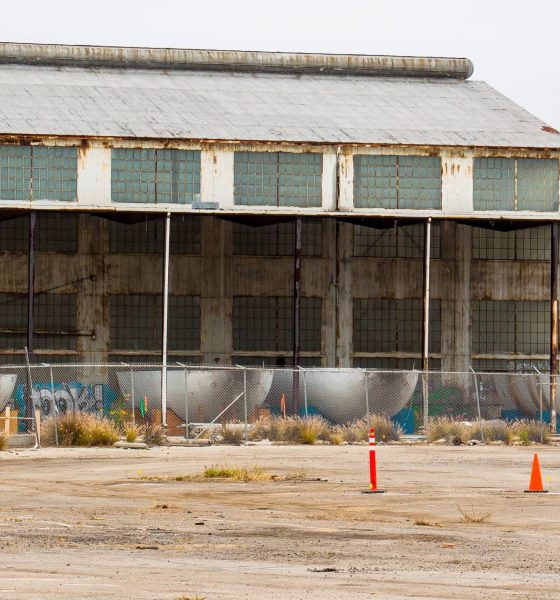
News
SpaceX’s BFR factory in LA spied with four Falcon 9 fairing halves
In an unexpected turn of events, Teslarati photographer Pauline Acalin came across a remarkable scene in Port of Los Angeles – four flight-proven Falcon 9 fairing halves temporarily stored on a plot of land soon to become SpaceX’s dedicated BFR factory.
While it’s difficult to guess exactly which fairing half is which, it appears that the halves from PAZ, Iridium-5, and Iridium-6 are present and accounted for. Reminiscent of SpaceX’s late-2016, early-2017 struggles with finding enough space to store their massive flight-proven Falcon 9 boosters, these fairing halves are unable to be reused as a consequence of too much saltwater exposure, making it significantly easier for the company to effectively find any old plot of SpaceX land on which to store them.

A massive panorama of Berth 240 shows the abandoned shipyard in all its gritty glory, as well as initial construction preparations underway. (Pauline Acalin)
Officially in early 2018, SpaceX is leasing Berth 240 with the explicit intent of constructing a dedicated facility for production of their first Mars rocket prototypes, as well as the relocation of Falcon 9 and Dragon recovery ops, which are quite space-constrained at their current berths. By all appearances, contractor Buntich is staging equipment ahead of initial demolition, refurbishment, and construction operations at Berth 240. Known predominately for pipeline and utility construction and refurbishment, it’s likely that the contractor is in the very early stages of modernizing the decades-abandoned shipyard, particularly, utilities like water, gas, electricity, and more.
- One half of SpaceX’s Iridium-6/GRACE-FO just moments before touchdown on the Pacific Ocean. (SpaceX)
- From left to right, my best guess for each fairing is PAZ, Iridium-6 Half 1, Iridium-5, and Iridium-6 Half 2. (Pauline Acalin)
- Less than a year after SpaceX quite literally scrapped its Port of San Pedro presence, the company is again in talks to build a Starship factory in California. (Pauline Acalin)
It may be fairly clear why SpaceX is storing four massive, unwieldy, and unreusable Falcon 9 fairing halves at Berth 240, but it’s much less clear what exactly their fates will be. With yet another added to the pack just this morning after a successful half recovery post-SES-12, SpaceX’s awkward fairing fleet is likely up to six structurally-intact halves now. These halves could be used for drop testing to perfect fairing recovery accuracy and ensure, at long last, that recovery vessel and claw-boat Mr Steven can catch them out of the air, avoiding the vast majority of exposure to seawater. SpaceX CEO Elon Musk recently noted that Mr Steven’s net would apparently be massively expanded, quadrupling its area to relieve some of the burdens of precision currently placed almost entirely on each payload fairing’s navigational capabilities.
Yup, we are extending the net area by a factor of 4
— Elon Musk (@elonmusk) June 5, 2018
Whether drop testing will actually be conducted is thus unclear, as a decision to expand Mr Steven’s net at least partially indicates that SpaceX engineers are less confident in the each half’s ability to reduce their margins of error by approximately 50%. A quadrupling of usable area implies that Mr Steven’s net will most likely be stretched twofold length-wise and width-wise, or perhaps by 50% for the width and 150% for the length to avoid a need for either an elaborate arm retraction mechanism or a comically unwieldy net.
Either way, Mr Steven’s next fairing catch attempt is unlikely to occur until the Falcon 9 Block 5 launch of Iridium-7, currently no earlier than mid-July. This gives recovery engineers and technicians at least five weeks to refine fairing accuracy and expand Mr Steven’s net, and Pauline will undoubtedly be there to capture any significant developments aboard the eclectic vessel as both it and drone ship Just Read The Instructions prepare for a return to action.

News
Tesla adds 15th automaker to Supercharger access in 2025
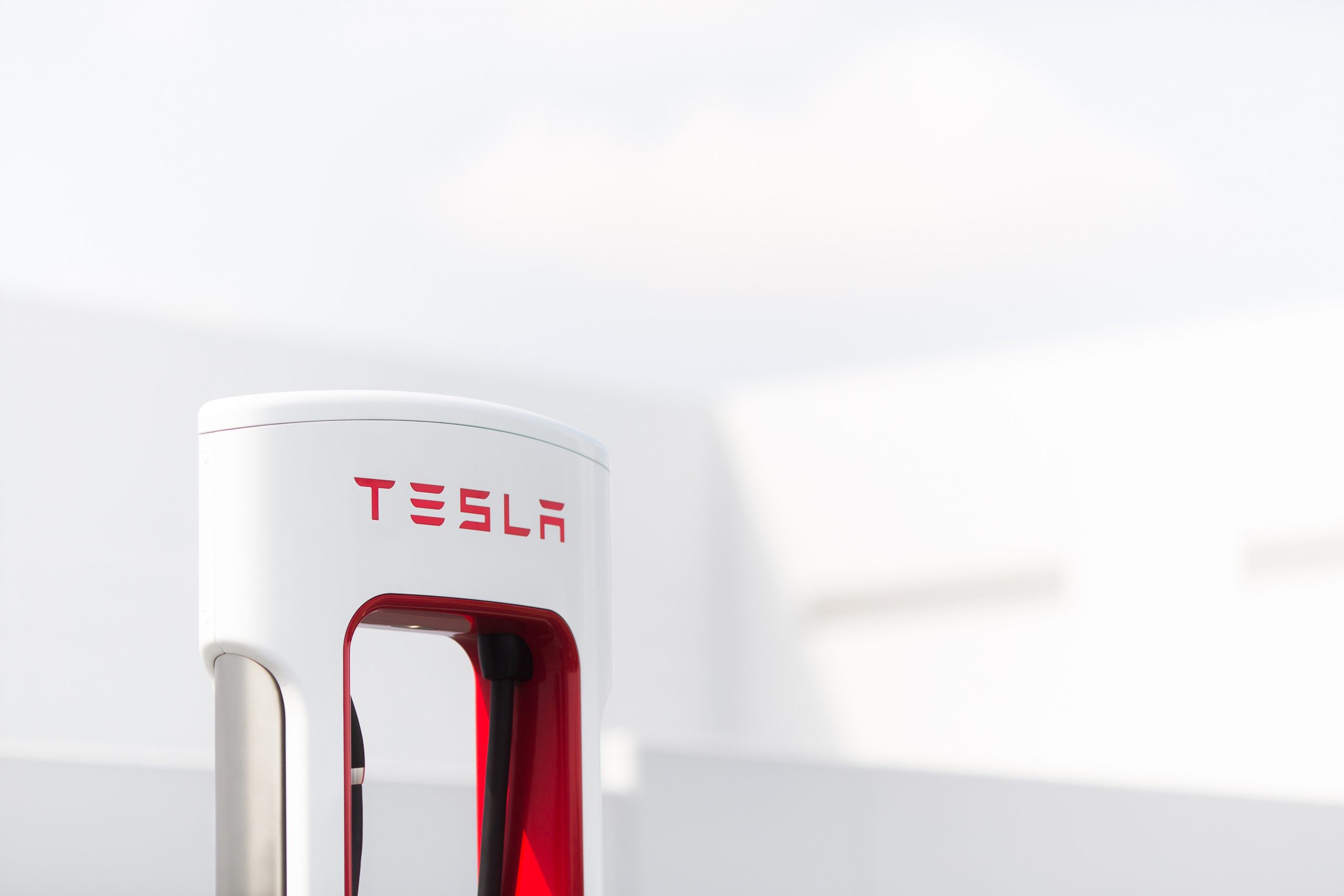
Tesla has added the 15th automaker to the growing list of companies whose EVs can utilize the Supercharger Network this year, as BMW is the latest company to gain access to the largest charging infrastructure in the world.
BMW became the 15th company in 2025 to gain Tesla Supercharger access, after the company confirmed to its EV owners that they could use any of the more than 25,000 Supercharging stalls in North America.
Welcome @BMW owners.
Download the Tesla app to charge → https://t.co/vnu0NHA7Ab
— Tesla Charging (@TeslaCharging) December 10, 2025
Newer BMW all-electric cars, like the i4, i5, i7, and iX, are able to utilize Tesla’s V3 and V4 Superchargers. These are the exact model years, via the BMW Blog:
- i4: 2022-2026 model years
- i5: 2024-2025 model years
- 2026 i5 (eDrive40 and xDrive40) after software update in Spring 2026
- i7: 2023-2026 model years
- iX: 2022-2025 model years
- 2026 iX (all versions) after software update in Spring 2026
With the expansion of the companies that gained access in 2025 to the Tesla Supercharger Network, a vast majority of non-Tesla EVs are able to use the charging stalls to gain range in their cars.
So far in 2025, Tesla has enabled Supercharger access to:
- Audi
- BMW
- Genesis
- Honda
- Hyundai
- Jaguar Land Rover
- Kia
- Lucid
- Mercedes-Benz
- Nissan
- Polestar
- Subaru
- Toyota
- Volkswagen
- Volvo
Drivers with BMW EVs who wish to charge at Tesla Superchargers must use an NACS-to-CCS1 adapter. In Q2 2026, BMW plans to release its official adapter, but there are third-party options available in the meantime.
They will also have to use the Tesla App to enable Supercharging access to determine rates and availability. It is a relatively seamless process.
News
Tesla adds new feature that will be great for crowded parking situations
This is the most recent iteration of the app and was priming owners for the slowly-released Holiday Update.
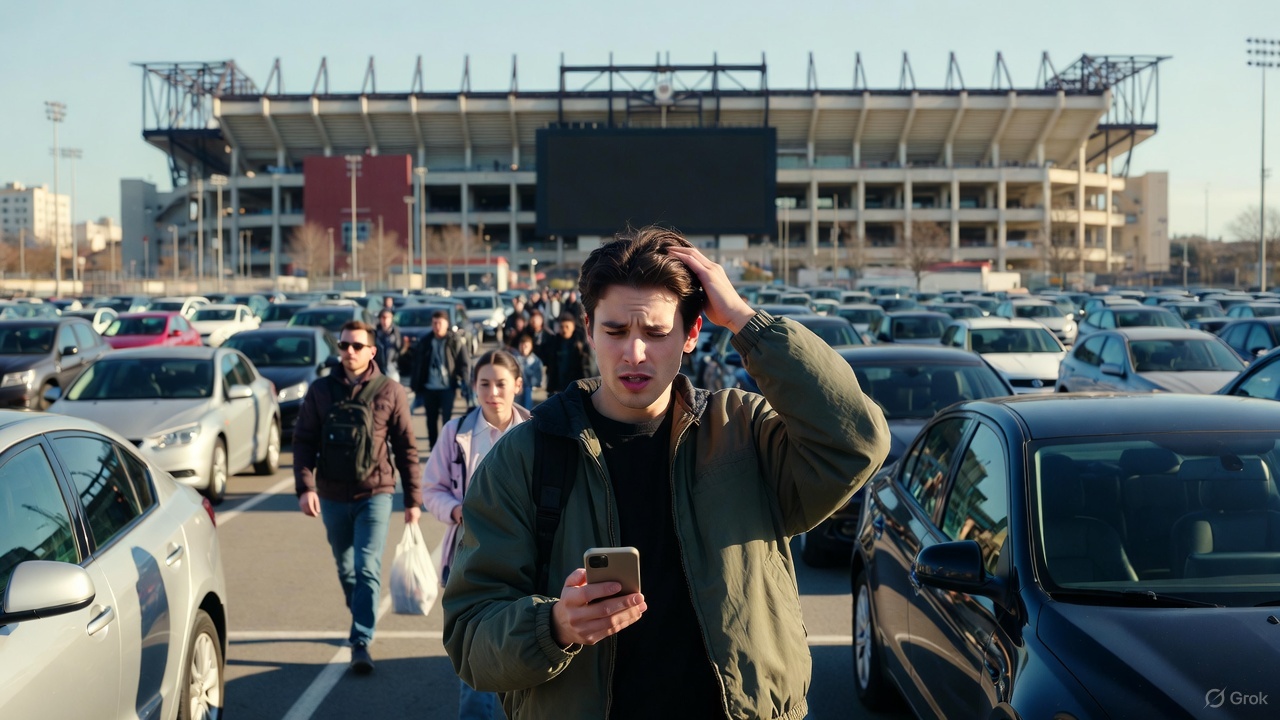
Tesla has added a new feature that will be great for crowded parking lots, congested parking garages, or other confusing times when you cannot seem to pinpoint where your car went.
Tesla has added a new Vehicle Locator feature to the Tesla App with App Update v4.51.5.
This is the most recent iteration of the app and was priming owners for the slowly-released Holiday Update.
While there are several new features, which we will reveal later in this article, perhaps one of the coolest is that of the Vehicle Locator, which will now point you in the direction of your car using a directional arrow on the home screen. This is similar to what Apple uses to find devices:
Interesting. The location arrow in the Tesla app now points to your car when you’re nearby. pic.twitter.com/b0yjmwwzxN
— Whole Mars Catalog (@wholemars) December 7, 2025
In real time, the arrow gives an accurate depiction of which direction you should walk in to find your car. This seems extremely helpful in large parking lots or unfamiliar shopping centers.
Getting to your car after a sporting event is an event all in itself; this feature will undoubtedly help with it:
The nice little touch that Tesla have put in the app – continuous tracking of your vehicle location relative to you.
There’s people reporting dizziness testing this.
To those I say… try spinning your phone instead. 😉 pic.twitter.com/BAYmJ3mzzD
— Some UK Tesla Guy (UnSupervised…) (@SomeUKTeslaGuy) December 8, 2025
Tesla’s previous app versions revealed the address at which you could locate your car, which was great if you parked on the street in a city setting. It was also possible to use the map within the app to locate your car.
However, this new feature gives a more definitive location for your car and helps with the navigation to it, instead of potentially walking randomly.
It also reveals the distance you are from your car, which is a big plus.
Along with this new addition, Tesla added Photobooth features, Dog Mode Live Activity, Custom Wraps and Tints for Colorizer, and Dashcam Clip details.
🚨 Tesla App v4.51.5 looks to be preparing for the Holiday Update pic.twitter.com/ztts8poV82
— TESLARATI (@Teslarati) December 8, 2025
All in all, this App update was pretty robust.
Elon Musk
Tesla CEO Elon Musk shades Waymo: ‘Never really had a chance’

Tesla CEO Elon Musk shaded Waymo in a post on X on Wednesday, stating the company “never really had a chance” and that it “will be obvious in hindsight.”
Tesla and Waymo are the two primary contributors to the self-driving efforts in the United States, with both operating driverless ride-hailing services in the country. Tesla does have a Safety Monitor present in its vehicles in Austin, Texas, and someone in the driver’s seat in its Bay Area operation.
Musk says the Austin operation will be completely void of any Safety Monitors by the end of the year.
🚨 Tesla vs. Waymo Geofence in Austin https://t.co/A6ffPtp5xv pic.twitter.com/mrnL0YNSn4
— TESLARATI (@Teslarati) December 10, 2025
With the two companies being the main members of the driverless movement in the U.S., there is certainly a rivalry. The two have sparred back and forth with their geofences, or service areas, in both Austin and the Bay Area.
While that is a metric for comparison now, ultimately, it will not matter in the coming years, as the two companies will likely operate in a similar fashion.
Waymo has geared its business toward larger cities, and Tesla has said that its self-driving efforts will expand to every single one of its vehicles in any location globally. This is where the true difference between the two lies, along with the fact that Tesla uses its own vehicles, while Waymo has several models in its lineup from different manufacturers.
The two also have different ideas on how to solve self-driving, as Tesla uses a vision-only approach. Waymo relies on several things, including LiDAR, which Musk once called “a fool’s errand.”
This is where Tesla sets itself apart from the competition, and Musk highlighted the company’s position against Waymo.
Jeff Dean, the Chief Scientist for Google DeepMind, said on X:
“I don’t think Tesla has anywhere near the volume of rider-only autonomous miles that Waymo has (96M for Waymo, as of today). The safety data is quite compelling for Waymo, as well.”
Musk replied:
“Waymo never really had a chance against Tesla. This will be obvious in hindsight.”
Waymo never really had a chance against Tesla. This will be obvious in hindsight.
— Elon Musk (@elonmusk) December 10, 2025
Tesla stands to have a much larger fleet of vehicles in the coming years if it chooses to activate Robotaxi services with all passenger vehicles. A simple Over-the-Air update will activate this capability, while Waymo would likely be confined to the vehicles it commissions as Robotaxis.
